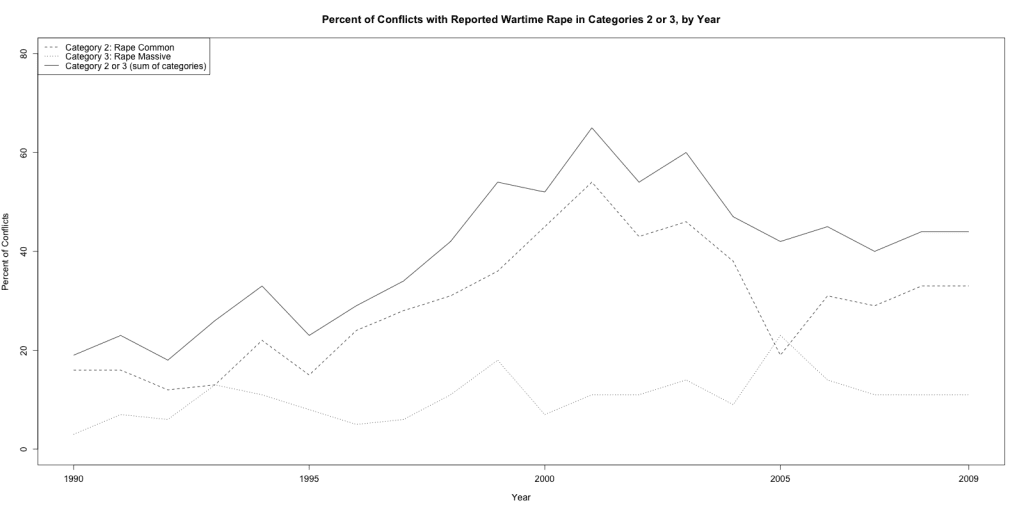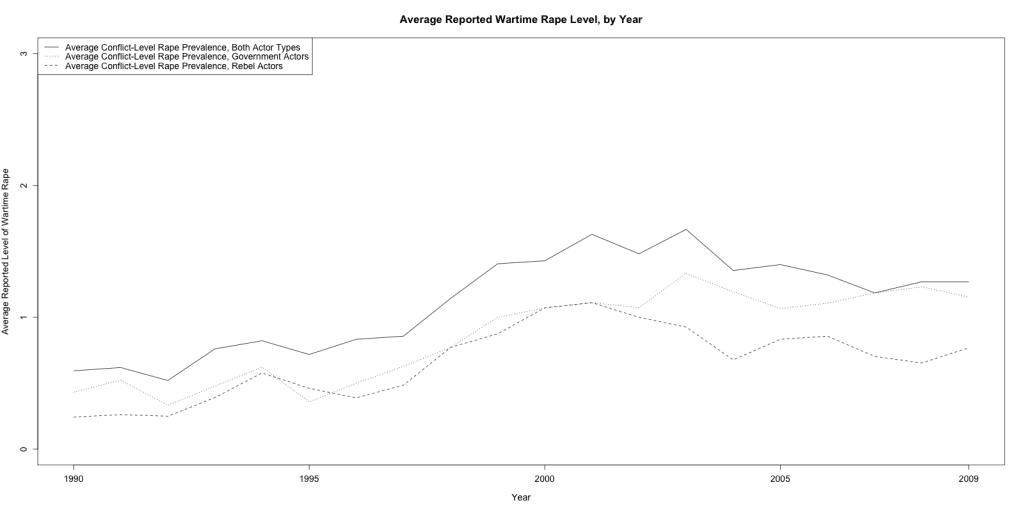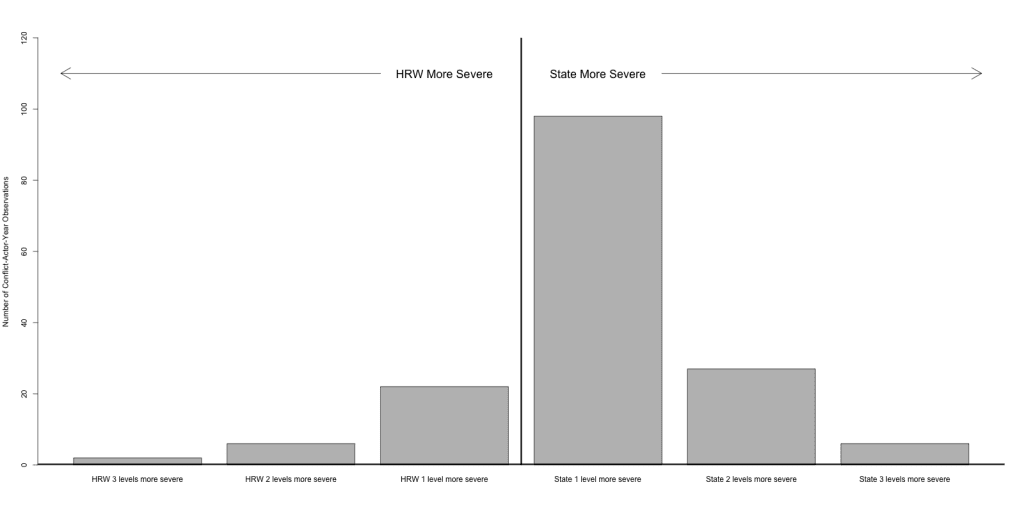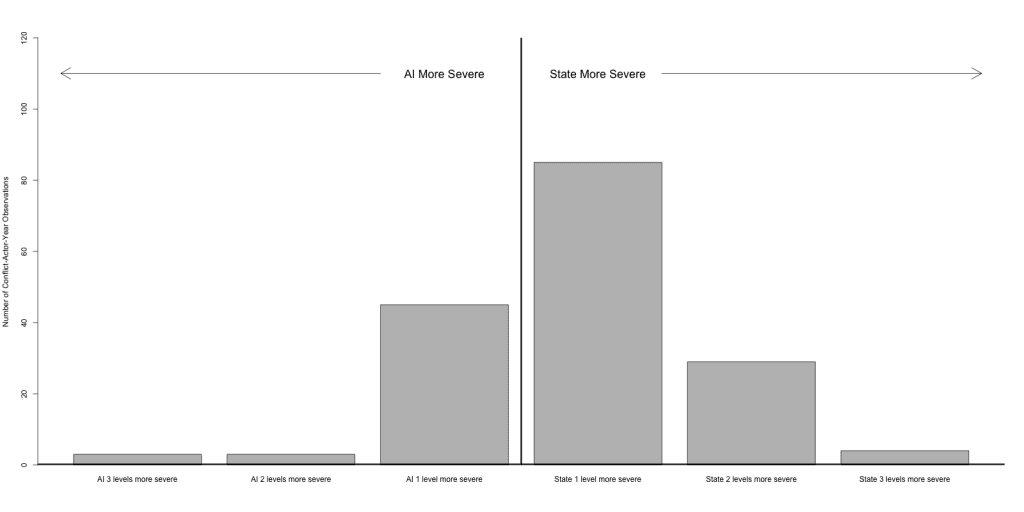This is a guest post by Amelia Hoover Green (Drexel University), Dara Kay Cohen (Harvard Kennedy School) and Elisabeth Jean Wood (Yale University). See also Megan H. MacKenzie’s post and Andrew Mack’s reply. tl;dr notice: 3,608 words
The Human Security Report (HSR) released last week has attracted considerable attention in both the news media and the blogosphere (the debate is collected here), mostly related to its assertion that wartime sexual violence may be on the decline globally. It is an attention-grabbing claim that is no more supported by data (indeed, somewhat less supported by data) than claims about the rising incidence of wartime sexual violence.
As scholars who research conflict-related rape and sexual violence—two of us provided input to the HSR[1]—we are concerned about both the global decline claim (we’ll refer to it as the GDC throughout) and the disproportionate attention it has received. In particular, we are troubled that the debate over the GDC has overshadowed other findings that are both more important and more grounded in evidence.
In this response, we first briefly review several important points of agreement with the HSR.[2] We then discuss our disagreements with the GDC, and with the HSR’s use of data to support the GDC. We nonetheless argue that cross-national data on wartime sexual violence are essential to understanding patterns of perpetration. While acknowledging that cross-national data have inherent biases, we maintain that such data have advanced our knowledge about the phenomenon of wartime rape. Some key findings from these data include the following:
- States, not rebel groups, are more frequently reported as perpetrators of wartime rape.
- Wartime rape is not (only) an African issue: Civil wars with high levels of wartime rape, when considered as a proportion of all civil wars, were only slightly more common in sub-Saharan Africa than in Asia.
- Despite the conventional wisdom, ethnic war is not a statistically significant predictor of wartime rape.
First, on points of agreement. We concur with the HSR—and with most authors in this field—that analyzing variation in the prevalence and patterns of sexual violence is key to understanding and prevention. We have each emphasized in our work that documenting and analyzing variation—increases and decreases over time and space, differences between perpetrating groups, distinct patterns against different victim groups and so on—is vital to both academic literature and policy work. Wood, in particular, has emphasized that the existence of variation demonstrates that conflict-related sexual violence is not inevitable, thereby strengthening the grounds for holding accountable those groups that do engage in wartime rape.
We believe that it is important to distinguish between focusing on highly visible conflicts that featured wartime sexual violence, and understanding the full pattern of variation. In particular, we note the importance, for both social science and policy, of the fact that in some conflicts there are few or no reports of rape, and that many armed groups (both states and rebels) engage in little reported rape. So we strongly endorse the HSR’s call for more research on such conflicts and on armed groups who have effectively prohibited sexual violence.
Below, we set our many agreements aside to review three key areas where we strongly disagree with the HSR. In our view, arguments around the GDC have hindered, rather than encouraged, progress in understanding wartime sexual violence. Worse, these arguments have led to misunderstandings of key data, and possibly to a poorer understanding of the phenomenon itself.
1. The GDC is not supported by existing data
In a rejoinder to Megan MacKenzie’s critique of the GDC, Andrew Mack maintains that the HSR’s key argument is that claims about rising incidence are not supported by reliable evidence—not that wartime sexual violence is definitely declining. He asserts that MacKenzie “conveniently misses” caveats about the GDC in the report.
Yet except via reference to “indirect evidence,” the HSR itself does little to clarify that evidence for the GDC is no stronger than the evidence supporting claims of rising sexual violence (which are strongly critiqued in the report). As we understand it, the evidence base for the GDC, laid out on page 27 of the HSR, is as follows: the number of high-intensity conflicts has declined, and the number of deaths in conflict, as measured by one frequently-used dataset on battle deaths, has also declined. Therefore, overall conflict intensity has declined. If overall conflict intensity has declined, then wartime sexual violence is also likely to have declined. This argument is largely based on two assumptions: (1) that declines in reported battle deaths (the measure of conflict intensity discussed in the HSR) represent actual declines in overall conflict deaths, and (2) that conflict intensity is a proxy for sexual violence.
The assertion that conflict-related mortality has declined remains open to debate.[3] And even if we accept assumption (1), we believe that assumption (2)—while true for some conflicts and armed groups—can’t be assumed at the global level. The vast majority of research on violence against civilians suggests that repertoires of violence differ between groups, and within groups over time.[4] For example, assumption (2) would suggest that the Peruvian state forces and the Shining Path, which committed similar numbers of civilian killings (and thus, by the HSR’s logic, engaged in similarly intense violence), should also have committed similar levels of sexual violence against civilians. However, while sexual violence by the Shining Path occurred in some areas, it was by no means as common as sexual violence by state forces.[5] Similarly, in work by one of us (Amelia Hoover Green), on violence during the civil war in El Salvador (1980-92), sexual violence was much more highly correlated with other non-lethal forms of violence than with killings, and killings and non-lethal violence followed separate, uncorrelated patterns.[6]
Recent research has found that several other highly lethal armed actors have effectively prohibited rape against civilians, including the Tamil Tigers (the LTTE), the Salvadoran insurgent group (FMLN), and some state militaries. On the level of the conflict, as well as the level of the armed group, researchers have not uncovered any straightforward relationship between lethal and sexual violence. It is not possible to infer a decline in wartime sexual violence from a decline in observed wartime deaths.
2. The GDC offers only one interpretation of the existing cross-national data
One of the authors of this post, Dara Kay Cohen, is the first scholar to collect a comprehensive cross-national dataset on wartime rape over a substantial period of time.[7] These data show a marked increase in reported rape by conflict-actors over the study period (1980-2009). The HSR authors have only partially reported findings from Cohen’s data, and then used these as supportive of the GDC—a selective presentation that been amplified by interlocutors who assume that the HSR interpretation is the only interpretation and that the data themselves are “complex,” “hollowed out,” “inadequate,” and fraught with “gender failings.”
From the US State Department Human Rights Country Reports, Cohen coded wartime rape by conflict actors (not sexual violence more broadly defined, nor violence by family members) for each conflict-actor type-year on a 0-3 ordinal scale. 0 indicates no reports of wartime rape by that actor type (either states or rebels), 1 indicates isolated or “some” reports, 2 indicates reports of “common, persistent or frequent” wartime rape, and 3 indicates that conflict-related rape was described as massive or systematic. Cohen has repeatedly clarified that these codes are based on qualitative descriptions of the nature of the violations. (Indeed, this is a strength of the dataset, particularly because comprehensive cross-national data on the number of victims or incidents does not exist.) In reporting summary statistics, Cohen frequently groups categories 2 and 3 together as referring to worryingly high levels of wartime rape.
According to the data, during 2000-2009, 44% of conflict-years experienced common or massive (level 2 or 3) wartime rape. By comparison, during 1980-1999, the data classify only about 16% of conflict-years as common or massive (level 2 or 3). Clearly, according to these data, the proportion of conflict-years with reports of common or massive wartime rape isincreasing. In a paper analyzing the causes of wartime rape, Cohen writes: “In the period of study, 1980-2009, I found reports of significant rape in almost two-thirds of the civil conflicts….That the problem is so common highlights the need for a better understanding of its causes.”
By contrast, in their presentation of the GDC, the HSR authors presented only the changing proportion of country-years classified at the highest severity level (3) and only data from the final ten years of the data collection (2000-2009). Andrew Mack has written that the HSR disregarded conflict-years prior to 2000 because research suggests that all human rights violations were under-reported during this period.
We believe the HSR’s decision not to present the data more fully has caused considerable confusion. A better approach would have summarized the data in their entirety, leaving readers to draw their own conclusions about likely levels of under-reporting during the first 20 years of the data collection—and most importantly, would have clarified that there is more than one way to interpret the evidence.
Some scholars argue that over-time increases in both number and severity of reported wartime rapes (that is, rape is described both more often and in more severe terms over time) indicate that rape is, in fact, becoming more frequent and more severe. Others argue that scholars, practitioners and advocates are simply better at detecting and reporting human rights violations, including wartime rape, in recent years than we were in the past.[8] As we have argued elsewhere, the relationship of reporting to reality is not clear, and we do not believe that there is definitive evidence for either of these propositions. But what we can say definitively is that these data show increasing, not decreasing, reports of wartime rape.
Even if we discard the first ten years of Cohen’s data collection (1980-1989)—deferring to Mack’s assumption that earlier human rights reports vastly under-reported the incidence of wartime rape—the data clearly show an overall upward trend in wartime rape between 1990 and 2009. As shown in the first graph below, the average reported prevalence score increases from 0.59 in 1990 (on Cohen’s 0-3 scale) to 1.27 in 2009.
Our second graph also shows an overall upward trend between 1990 and 2009. In 1990, only about 20% of conflicts experienced the two highest levels of wartime rape. The percentage jumped to 65% by 2001 and remained high at 44% in 2009.

Categories of reported wartime rape prevalence over time. Graph by Amelia Hoover Green using data from Cohen (2012).
3. Responding to concerns about the cross-national data
In the firestorm surrounding the HSR, several observers who are concerned about bias have criticized the data collection itself. There are three important responses to these critiques.
First, we all recognize that no single data collection can ever definitively measure wartime rape or other forms of sexual violence. Quantitative cross-national approaches to wartime sexual violence are only one of a number of methods that are jointly required to consider the nature and magnitude of wartime sexual violence.[9] All three of us have employed numerous other methodologies and data sources to supplement and to complement cross-national data—including ethnographic fieldwork, quantitative data collection at the sub-national level, sample surveys, structured and semi-structured interviews, and oral histories and testimonies from both perpetrators and victims.
Second, while critiques of the State Department Human Rights Country Reports are valid and important, we believe cross-national data collections are a valuable source of information about wartime sexual violence and other rights abuses. Without Cohen’s dataset, we would not know that, at a global level, state armed groups are more frequently reported as perpetrators than are rebels. We would not know that wartime rape is not “an African issue”—the percentage of conflicts in Africa with the highest two levels of reported rape is only slightly greater in Sub-Saharan Africa than in Asia. And we would not know that, overall, ethnic wars are no more likely than non-ethnic wars to feature rape.
In addition, State Department reports included information about conflict-related rape by armed actors as early as 1981, long before the Bosnian conflict increased international attention to wartime rape. The State Department cited sexual violations by even strong allies; for example, sexual violations by the Salvadoran counterinsurgency at the height of U.S military support. And there were reports of high levels of wartime rape even in societies that were essentially closed to foreigners, such as Burma/Myanmar. (Non-State Department sources that also cover human rights violations yearly, for every country, are extremely rare.[10])
Nevertheless, potential biases in data based on State Department reports are worth considering carefully. Cohen, Ragnhild Nordås and colleagues at PRIO are analyzing differences in data sources, as part of the development of a new Sexual Violence in Armed Conflict (SVAC) dataset. The SVAC dataset, currently complete for conflicts in Africa from 1989 to 2009 (the subset is known as SVAC-Africa), compares codings of sexual violence (broadly defined) based on State Department reports to those based on reports from Amnesty International (AI) and Human Rights Watch (HRW).
In findings from the SVAC-Africa dataset, the vast majority of observations (86% of conflict-actor-years) show complete agreement between the three sources. On average, the State Department reports a higher prevalence of sexual violence than do HRW or AI reports. Moreover, in a majority of cases of disagreement between State Department codings and HRW or AI codings (see figures below), the State Department data report a more severe prevalence than do HRW or AI.
In the figures below, the bars to the right of the vertical line represent conflict-actor-year observations for which the State Department reported a higher prevalence of wartime rape than Human Rights Watch (first figure) and AI (second figure). The bars to the left of the vertical line represent observations in which HRW and AI reported more serious wartime rape (first and second figures, respectively). While HRW and AI reported more serious wartime rape for some conflict-actors in some years, it is clear that, in general, the State Department actually tended to report more serious violence than either HRW or AI. This is true for both government and rebel group actor types (not shown).
Nothing in this analysis suggests that State Department reporting is unbiased, or that there is no room for improvement. It does, however, provide strong evidence that the State Department reports represent the most comprehensive currently available single source for cross-national comparisons of wartime rape by armed actors. More generally, it is important to note that coding quantitative data from qualitative reports, including data from State Department reports and data about gender issues, is a common practice among quantitative human rights scholars, and has yielded dozens of important studies on repression and human rights.
A third and final critique of State Department country reports concerns gender bias specifically. Some scholars have criticized the reports for not reporting more systematically on gender issues including (but not limited to) domestic violence, gender-related crimes, progress made by local women’s movements, and women’s legal rights. This is absolutely true; State Department reporting is by no means a comprehensive source of information on the many forms of physical and structural violence against women. Again, however, with respect to one key aspect of human rights—wartime rape by armed actors, the subject of Cohen’s study—State Department data are significantly more attuned to violations than are other comparable existing sources. In addition—and rather remarkably—State Department reports included details about wartime rape in armed conflict well before international attention to atrocities in the Balkans and Rwanda placed wartime rape on the international agenda.
In sum, State Department reports are the currently the best single source for a comprehensive cross-national look at wartime rape. The next goal for cross-national research is comparisons of multiple cross-national sources, which is precisely what the SVAC data project aims to accomplish.
Conclusion: The GDC is a distraction from more important issues
Having detailed the problems that we see with the GDC, we turn toward what we view as the real problem with the GDC debate, at least in policy terms. A contested global trend in wartime rape is simply irrelevant to policy in any given conflict zone, and to the local patterns that inform, or should inform, evidence-based policy responses to conflict-related sexual violence.
Focusing on global patterns aggregated from conflict-level data is not particularly useful, either for academic analysis or for evidence-based policy-making. Rather than debating the GDC, both academics and policymakers should instead focus on variation between armed groups (both state and non-state). What we need to know is why some armed groups engage in high levels of wartime rape and why others do not—often within the same conflict. Understanding this puzzle will provide important support to those advocating prevention of, and accountability for, war crimes of sexual violence.
Along with other observers, we worry that the GDC could lead policymakers to decrease overall allocation of resources for both aid and research, despite the HSR’s explicit plea for more such resources. We worry, also, that public and scholarly attention to the GDC could decrease attention to more important “missing pieces” in our knowledge of wartime sexual violence, or worse, could decrease attention to the phenomenon itself. In short, over-confident statements about global trends—in either direction—obscure the need for better local, regional and national data, and cloud the understandings that scholars have created.
[1] Cohen and Hoover Green were part of an Expert Group Meeting at the Human Security Report Project in 2010; both provided background papers for this HSR. In addition, Cohen commented on draft versions of two chapters.
[2] We are co-authoring a policy brief for USIP that will expand on the issues raised in this post.
[3] While the number of high-intensity conflicts has declined, declines in the number of conflict-related deaths are less certain. Literatures in demography, political science and other fields attest to the difficulty of accurately measuring conflict-related violence. Without accurate, verifiably comparable measurements, measuring over-time global trends is likely to remain an uncertain enterprise.
[4] Amelia Hoover Green has written extensively about “repertoires of violence” during armed conflict, i.e., the types of violence commonly used by armed groups, and the relative frequency of those types. She is currently at work on a book manuscript, “Repertoires of Violence: The Role of Armed Group Institutions and Ideologies,” to follow her Ph.D. thesis of the same title. Other researchers who have considered repertoires in depth include Francisco Gutierrez Sanín and James Ron.
[5] The final report of the Peruvian Truth and Reconciliation Commission (Comisión de Verdad y Reconciliación) can be found here. Also see reports from the Benetech Human Rights Data Analysis Group, which completed a Multiple Systems Estimation on lethal violence in Perú, and the work of Michele Leiby on sexual violence by state forces.
[6] According to Amelia Hoover Green’s work on violence in El Salvador, the Salvadoran state used very high levels of non-lethal violence, including sexual violence, throughout the Salvadoran conflict, but killings by state forces reached a peak in 1981 or 1982 and declined very significantly thereafter. On the rebel side, the Farabundo Martí National Liberation Front committed very little sexual violence, and its use of sexual violence failed entirely to track its use of lethal violence, over time or space.
[7] Scholars had previously collected a database of newspaper reports and had coded State Department and AI reports for a single year.
[8] The HSR briefly refers to this debate on page 27: “Dara Cohen’s new dataset indicates that reported sexual violence in the average civil conflict has increased over time…. But it is important to note that this finding does not necessarily mean that sexual violence itself has increased. So, it is quite possible, indeed we believe likely, that reporting of sexual violence has increased sharply as interest and concern about it has grown. At the same time, the dramatic decline of conflict intensity makes it highly unlikely that the level of conflict related sexual violence has increased globally.”
[9] See, for example, the call for mixed-method research in the work of Francoise Roth, Tamy Guberek and Amelia Hoover Green, and the ethical concerns about human rights measurement voiced by Shana Swiss and Peggy Jennings. Even in peacetime situations, the difficulties of measuring rape prevalence are significant.
[10] To increase confidence in the quality of her State Department-based data, Cohen compared the coding of wartime rape from the State Department reports to the coding of sexual violence in the PRIO SVAC-Africa dataset. The PRIO data use a broader set of sources to code data, which includes the State Department reports, as well as reports from Amnesty International and Human Rights Watch. There is not perfect overlap in either conflicts (Cohen bases hers on Fearon’s conflict data; PRIO bases theirs on the UCDP conflict data) or dates between the datasets; nonetheless, there is close agreement across the datasets when comparing the highest reported levels of rape/sexual violence for the cases that appear in both datasets. Of the 18 conflicts that appear in both datasets, ten cases had identical codes for the highest levels of reported rape/sexual violence. Of the cases where coding differed, there was only one case of disagreement that resulted from the sources used (where the State Department reported a lower level than HRW and AI). The other sources of disagreement all resulted from differences in either the unit of analysis or the coding rules. Even given these differences, there was perfect agreement for the highest level of rape/sexual violence for state actors in 67% of the conflicts, and for rebel actors in 72% of the conflicts. In cases of disagreement, the codes all differed by only one level—there were no cases in which the highest codes differed by two levels or greater.
Daniel H. Nexon is a Professor at Georgetown University, with a joint appointment in the Department of Government and the School of Foreign Service. His academic work focuses on international-relations theory, power politics, empires and hegemony, and international order. He has also written on the relationship between popular culture and world politics.
He has held fellowships at Stanford University's Center for International Security and Cooperation and at the Ohio State University's Mershon Center for International Studies. During 2009-2010 he worked in the U.S. Department of Defense as a Council on Foreign Relations International Affairs Fellow. He was the lead editor of International Studies Quarterly from 2014-2018.
He is the author of The Struggle for Power in Early Modern Europe: Religious Conflict, Dynastic Empires, and International Change (Princeton University Press, 2009), which won the International Security Studies Section (ISSS) Best Book Award for 2010, and co-author of Exit from Hegemony: The Unraveling of the American Global Order (Oxford University Press, 2020). His articles have appeared in a lot of places. He is the founder of the The Duck of Minerva, and also blogs at Lawyers, Guns and Money.





A most welcome intervention, and a very informative focus on State Department sources and why they were chosen. Given that the discussion here is so much more detailed than that offered by the HSR itself, it also makes a mockery of the idea (if it still persists in certain places) that blogs are for trivial and half-argued positions whilst articles and reports are for the serious stuff. The accumulated criticisms of the HSR that have emerged over the last weeks will hopefully make people think quite seriously indeed about it, and about the decline thesis in particular.
There’s more to be said about the stickiness of methodological and analytical differences (I’m struck in particular by how academic critics, whilst united in the tone of their opposition to the HSR, have nevertheless differed quite markedly on the grounds for their opposition), and it’s unlikely that there will ever be a consensus position on exactly how to study wartime sexual violence (or anything else), although the practice of multiple methodologies and angles is surely to be welcomed, and again adds a dimension lacking from the HSR’s generalisations.
One other small comment. In my own piece, I didn’t “amplify selectivity” or “assume that the HSR interpretation is the only one”. I repeatedly said that Cohen had made caveats that the HSR had not, and also agreed that there is no way not to think of these issues without some reference to questions of cross-case comparison and variation.
A great contribution. I hope the HSR team will link the report to this blogpost so that those who would like to see the operationalizations and assumptions behind the idea of a global decline in wartime sexual violence can decide for themselves whether these are warranted or not.
Fantastic! Excellent research simply decimates the report time and time again. If only we could reverse all those headlines it created…
To be a little clearer about the purpose of our post — the main point for us is that the GDC distracts from other, more important (and better-supported) claims in the HSR. We really *didn’t* intend to “decimate” the report itself — as we noted, we share many points of agreement. That said, I’m glad that our close read of the GDC is useful.
Amelia / Dara / Elisabeth, Thank you for this very interesting
posting, I learned a few new things. The GDC of the HSR is that “the
absolute level of conflict-related sexual violence has decreased, rather
than increased, in recent years”. I
agree with you that the mere assumption that decrease in the number of
conflicts brings decrease in SV is not enough because such correlation
is far from being established.
Nevertheless your posting responds to this claim not with any estimate of “the absolute level”, but only with an assessment of relative levels of prevalence among the conflicts active within every year (in the two charts, either by average
or by percentage). In my view to respond to the GDC it would be more
relevant to show the trend of the total number of conflicts with
significant SV active every year. Can you produce a graph to this
effect? Hypothetically it could happen that the absolute size decreases,
while the relative prevalence of SV per conflict increases, and both
things are true.
Thanks and best regards,
XA
This is a very good point. It’s true that, if the overall number of conflicts declined enough, overall SV could decline even as per-conflict SV increased. Mostly, though, I am inclined to think that this is another proof of the policy irrelevance of the GDC, which (along with defending Dara Cohen’s data from further misinterpretation) was the main point of our post. Presumably a decline in the world level of conflicts is not so helpful to victims of increasing SV in any given conflict area.